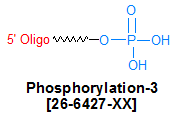In this section: Introduction | Quality Control | Purification | Modifications | Long Oligos | Price List
In this section: Introduction | Molecular Beacon FAQ's | Fluorescent Probes Price List | Other Fluorescent Molecular Probes
In this section: SPCT | DME SPCT Intro | Order DME TaqMan® Assays SPCT | SNP PCT Search | Gene Expression Assays | SPCT Design Center | GeneAssays
In this section: RNA Oligonucleotides | Quality Control | Purification | Modifications | RNAi Explorer™ Products and Prices | Custom RNAi | RNAi Design Guidelines | SmartBase™ siRNA Modifications | shRNA Explorer™
In this section: PCR Amplification & Analysis
In this section: Introduction | Genemer™ | GeneProber™ | Prober™ Gene Detection Kits | GScan™ Gene Detection Kits | Genemer™ Control DNA | Infectious Diseases
In this section: Gene Construction
In this section: Introduction | The Omni-Clean™ System | The Omni-Pure™ Plasmid Purification System | The Omni-Pure™ Genomic DNA Purification System | Viral DNA & RNA Purification | Microbial DNA Purification | Plant DNA Purification
In this section: Introduction | Quality Control | Purification | Modifications | Long Oligos | Price List
In this section: Introduction | Molecular Beacon FAQ's | Fluorescent Probes Price List | Other Fluorescent Molecular Probes
In this section: SPCT | DME SPCT Intro | Order DME TaqMan® Assays SPCT | SNP PCT Search | Gene Expression Assays | SPCT Design Center | GeneAssays
In this section: RNA Oligonucleotides | Quality Control | Purification | Modifications | RNAi Explorer™ Products and Prices | Custom RNAi | RNAi Design Guidelines | SmartBase™ siRNA Modifications | shRNA Explorer™
In this section: PCR Amplification & Analysis
In this section: Introduction | Genemer™ | GeneProber™ | Prober™ Gene Detection Kits | GScan™ Gene Detection Kits | Genemer™ Control DNA | Infectious Diseases
In this section: Gene Construction
In this section: Introduction | The Omni-Clean™ System | The Omni-Pure™ Plasmid Purification System | The Omni-Pure™ Genomic DNA Purification System | Viral DNA & RNA Purification | Microbial DNA Purification | Plant DNA Purification
Phosphorylation-3'
Phosphorylation-3'
Code : [3Phos]

Modification : Phosphorylation-3'
Catalog Reference Number
Category
Modification Code
5 Prime
3 Prime
Internal
Molecular Weight (mw)
Extinction Coeficient (ec)
Technical Info (pdf)
Absorbance MAX
Emission MAX
Absorbance EC
26-6427
Phosphorylation
[3Phos]
N
Y
N
79.98
-
PS26-6427.pdf
-
-
-
| Catalog No | Scale | Price | | 26-6427-05 | 50 nmol | $59.00 | | 26-6427-02 | 200 nmol | $59.00 | | 26-6427-01 | 1 umol | $119.00 | | 26-6427-03 | 2 umol | $216.00 | | 26-6427-06 | 5 umol | $535.50 | | 26-6427-10 | 10 umol | $950.00 | | 26-6427-15 | 15 umol | $1,188.00 |
At Gene Link two type of 5'-phosphorylation reagents are used; mostly it is CPR-I for oligos that are not destined to be purified based on reverse phase requiring the presence of DMT (dimethoxy trityl) group. The DMT group present on the CPR-I is not retained after deprotection with ammonium hydroxide.
CPR-II is used only for oligos that are requested by customers with 5'-phosphorylation DMT ON. These are assumed to be further purified by the customer using the DMT group that is retained after ammonium hydroxide deprotection. The coupling efficiency is nearly the same for both the phosphorylation reagents.
Application
Oligonucleotides containing a 5'-phosphate group find use in molecular biology for a variety of purposes: e.g., as linkers and adapters, in cloning and gene construction, and in the ligase chain reaction. The venerable T4 polynucleotide kinase has served researchers well by phosphorylating the 5'-terminus using ATP as the phosphate source. A chemical alternative to kinase, the sulfonyl ethyl phosphoramidite, Chemical Phosphorylation Reagent has become increasingly popular over the years since it is convenient to use on the synthesizer and the yield of 5'-phosphate is generally much higher than with kinase.(1) This reagent includes a dimethoxytrityl (DMT) protecting group which can be removed on the synthesizer to allow a determination of phosphorylation efficiency. However, the DMT protecting group can not be used for DMT-on purification. If the DMT group is intentionally left on the oligonucleotide, it is eliminated along with the sulfonyl ethyl group to produce the 5'-phosphate during the ammonium hydroxide deprotection. - Phosphorylation-3'
|
|
